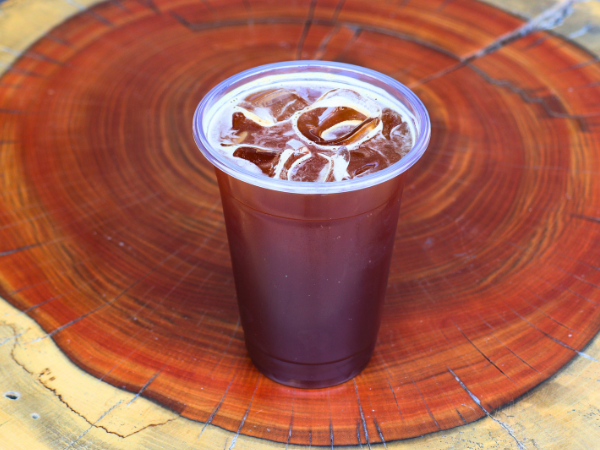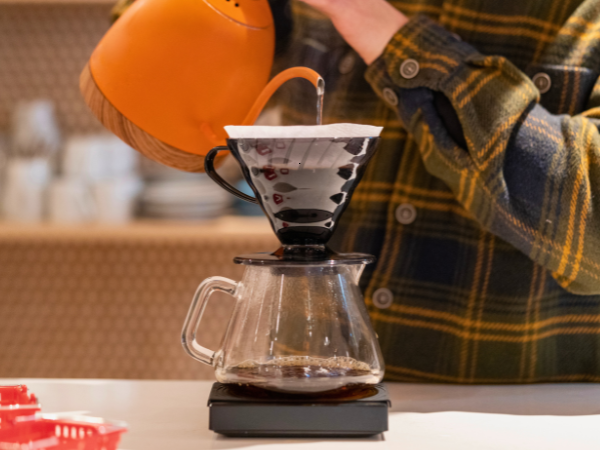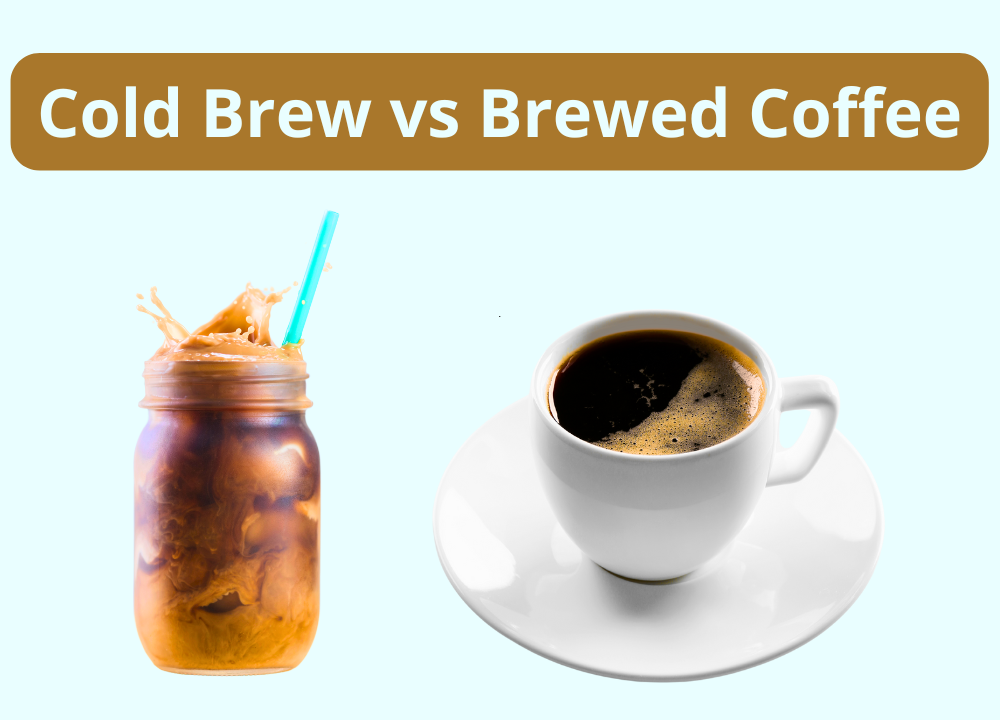Cold brew is made by steeping coarsely ground coffee beans in cold water for an extended period, typically 12-24 hours. This process yields a smoother, less acidic taste.
Brewed coffee, on the other hand, involves pouring hot water over finely ground coffee beans, extracting a robust and aromatic flavor.
What Is Cold Brew Coffee?
Cold brew coffee is a refreshing alternative to your regular hot coffee. Unlike hot coffee, cold brew is made without heat, resulting in a smoother, less acidic taste.
How Is Cold Brew Coffee Made?
Cold brew coffee is made by steeping coarsely ground coffee beans in cold water for an extended period. Typically, the brewing process lasts between 12 to 24 hours.
| Steps | Details |
|---|---|
| Step 1 | Grind the coffee beans coarsely. |
| Step 2 | Mix the ground coffee with cold water. |
| Step 3 | Let the mixture steep for 12 to 24 hours. |
| Step 4 | Strain the coffee to remove the grounds. |
Benefits Of Cold Brew Coffee
- Less acidic than hot brewed coffee, making it gentler on the stomach.
- Has a smoother, sweeter taste due to the slow extraction process.
- Can be stored in the refrigerator for up to two weeks.
- Versatile: Enjoy it black, with milk, or as part of other coffee drinks.
What Is Brewed Coffee?
Brewed coffee is the most common way to make coffee. It involves pouring hot water over ground coffee beans. The hot water extracts the flavors, creating a delicious drink.
Brewed coffee is also known as drip coffee. It is made using several methods, including automatic coffee makers, pour-over systems, and French presses.
Method Of Preparation
The preparation of brewed coffee is simple. Here’s a basic guide:
- Grind the coffee beans to a medium or coarse texture.
- Boil water and let it cool for about 30 seconds.
- Place the ground coffee in a filter or French press.
- Pour the hot water over the grounds.
- Allow it to brew for 4-5 minutes.
- Serve the coffee hot.
Brewing Time And Temperature: Cold Brew Vs Brewed Coffee
When comparing cold brew and brewed coffee, the brewing time and temperature play a critical role. These factors significantly impact the flavor, aroma, and overall experience of each drink.
Brewing Time
Cold brew coffee requires a much longer brewing time. Typically, it takes between 12 to 24 hours to achieve the desired taste. This extended period allows the coffee grounds to steep in cold water, extracting a smoother and less acidic flavor.
Brewed coffee, on the other hand, is much quicker. Using hot water, it usually takes only a few minutes to brew. This rapid extraction process results in a more robust and aromatic coffee.
Brewing Temperature
Cold brew is made using cold or room temperature water. The low temperature slows the extraction process, which can be beneficial for those who prefer a milder taste. This method avoids the bitterness often found in hot brewed coffee.
Brewed coffee uses hot water, typically between 195°F to 205°F (90°C to 96°C). The high temperature extracts more oils and flavors from the coffee grounds, producing a stronger and richer taste.
Flavor Profile
Cold brew coffee is known for its smooth, mild flavor. The long brewing time at a low temperature reduces acidity, making it a popular choice for those with sensitive stomachs.
Brewed coffee offers a bold and aromatic experience. The high temperature and short brewing time extract more flavors, providing a rich and intense taste.

Taste Differences Between Cold Brew And Brewed Coffee
Cold brew and brewed coffee are two popular ways to enjoy this beloved beverage. While both come from coffee beans, they offer distinct taste experiences. Understanding the taste differences can help you decide which brew suits your palate better.
Taste Profile Of Cold Brew Coffee
Cold brew coffee is known for its smooth, mild flavor. It often has a sweet, chocolatey taste. The cold brewing process reduces acidity, making it easier on the stomach.
Cold brew usually lacks the bitterness found in hot brewed coffee. This makes it a favorite for those who prefer a less intense coffee experience. Its smoothness allows the natural flavors of the coffee bean to shine.
Taste Profile Of Brewed Coffee
Brewed coffee offers a more traditional coffee flavor. It tends to be bolder and more robust. The hot water extracts complex flavors quickly, leading to a strong, aromatic cup.
This type of coffee often has a higher acidity, resulting in a bright, crisp taste. The bitterness can vary depending on the brew time and the coffee beans used. Many coffee lovers enjoy this complexity and depth.
Comparison Table: Cold Brew Vs Brewed Coffee Taste
| Aspect | Cold Brew Coffee | Brewed Coffee |
|---|---|---|
| Flavor | Sweet, Smooth, Chocolatey | Bold, Robust, Complex |
| Acidity | Low | High |
| Bitterness | Low | Varies |
| Aroma | Mild | Strong |
Best Use Cases For Each Type
- Cold Brew Coffee: Ideal for iced coffee lovers, those with sensitive stomachs, and people who prefer a sweeter, milder taste.
- Brewed Coffee: Perfect for traditional coffee drinkers, fans of bold flavors, and those who enjoy a rich, aromatic experience.
Acidity Levels
When comparing Cold Brew and Brewed Coffee, understanding the acidity levels is crucial. The acidity in coffee affects its taste, texture, and how it feels in your stomach.
Cold Brew Acidity
Cold Brew coffee is known for its smooth and mild flavor, largely due to its low acidity. The brewing process for Cold Brew involves steeping coffee grounds in cold water for an extended period, usually between 12 to 24 hours. This slow extraction process results in a coffee concentrate that is less acidic and less bitter compared to traditional hot-brewed coffee.
- Long steeping time: Cold Brew is steeped in cold water for up to 24 hours.
- Low temperature: The cold water extracts fewer acids from the coffee grounds.
- Smooth taste: The low acidity gives Cold Brew a smooth and mellow flavor.
To better understand the acidity levels, let’s compare Cold Brew and Brewed Coffee in a simple table:
| Coffee Type | Acidity Level (pH) |
|---|---|
| Cold Brew | 5.0 – 6.0 |
| Brewed Coffee | 4.5 – 5.0 |
The higher pH level in Cold Brew indicates it is less acidic than Brewed Coffee. This makes Cold Brew a preferable option for those with sensitive stomachs or acid reflux issues. The low acidity is also why many people find Cold Brew to be easier on their digestive systems and less likely to cause heartburn.

Brewed Coffee Acidity
Brewed Coffee, made using hot water, typically has higher acidity. The hot water extracts more acids from the coffee grounds quickly, resulting in a more acidic beverage. This higher acidity contributes to the bright, tangy flavors often associated with traditional coffee.
- Quick extraction: Hot water extracts acids from the grounds more rapidly.
- Higher temperature: The heat enhances the release of acidic compounds.
- Bright flavors: The higher acidity gives Brewed Coffee its characteristic tanginess.
While some coffee enthusiasts appreciate the vibrant flavors of Brewed Coffee, the higher acidity can be harsh on sensitive stomachs. The acidity level in Brewed Coffee typically falls between 4.5 and 5.0 pH, making it more acidic than Cold Brew.
For those who enjoy the classic taste of Brewed Coffee but want to reduce acidity, consider these tips:
- Use darker roasts: Darker roasts tend to have lower acidity.
- Opt for coarser grinds: Coarser grinds can result in less acidic coffee.
- Adjust the brewing time: Shorter brewing times can reduce acidity.
Caffeine Content Comparison: Cold Brew Vs Brewed Coffee
One key aspect to compare is the caffeine content. This factor influences your choice between these two popular coffee types.
Caffeine Levels In Cold Brew
Cold Brew coffee often contains more caffeine per serving. This is because it is made by steeping coffee grounds in cold water for an extended period, usually 12 to 24 hours. The result is a strong, concentrated coffee.
Here’s a comparison of caffeine content in Cold Brew:
| Serving Size | Caffeine Content |
|---|---|
| 8 oz | 200 mg |
| 12 oz | 300 mg |
| 16 oz | 400 mg |
Caffeine Levels In Brewed Coffee
Brewed Coffee, also known as drip coffee, usually has less caffeine. This is due to the hot water extraction method, which is quicker but extracts less caffeine compared to the cold brew process.
Here’s a comparison of caffeine content in Brewed Coffee:
| Serving Size | Caffeine Content |
|---|---|
| 8 oz | 95 mg |
| 12 oz | 140 mg |
| 16 oz | 190 mg |
Factors Influencing Caffeine Content
Several factors influence caffeine levels in both types of coffee:
- Type of Coffee Beans: Different beans have different caffeine levels.
- Brewing Time: Longer brewing times typically result in more caffeine.
- Water Temperature: Cold brew uses cold water, while brewed coffee uses hot water.
Choosing Based On Caffeine Needs
Choose Cold Brew if you need a higher caffeine kick. Opt for Brewed Coffee for a milder caffeine content. Your preference might depend on your daily caffeine intake and taste preference.
Health Benefits: Cold Brew Vs Brewed Coffee
Each type of coffee has its own unique taste, preparation method, and health benefits.
Lower Acidity Levels
One of the key benefits of cold brew coffee is its lower acidity. This makes it easier on the stomach. People with acid reflux or digestive issues may find cold brew more comfortable to drink. Lower acidity also means less enamel damage to your teeth.
Antioxidant Content
Brewed coffee is rich in antioxidants. These antioxidants help fight free radicals in your body. Free radicals can cause cellular damage. While cold brew also contains antioxidants, the levels are slightly lower. Brewed coffee may provide more antioxidant benefits overall.
Caffeine Levels
| Type of Coffee | Caffeine Content (per 8 oz) |
|---|---|
| Cold Brew | 200 mg |
| Brewed Coffee | 95 mg |
Cold brew typically has higher caffeine content. Higher caffeine can boost your energy levels. Brewed coffee has less caffeine, which might be better for those sensitive to caffeine. Choose based on your caffeine tolerance.
Calorie Count
- Cold Brew: Lower calorie count if consumed black.
- Brewed Coffee: Similar calorie count when consumed black.
Both types are low in calories. Adding milk, sugar, or syrups increases calorie count. Cold brew is often consumed with less added sugar. This can make it a healthier choice.

